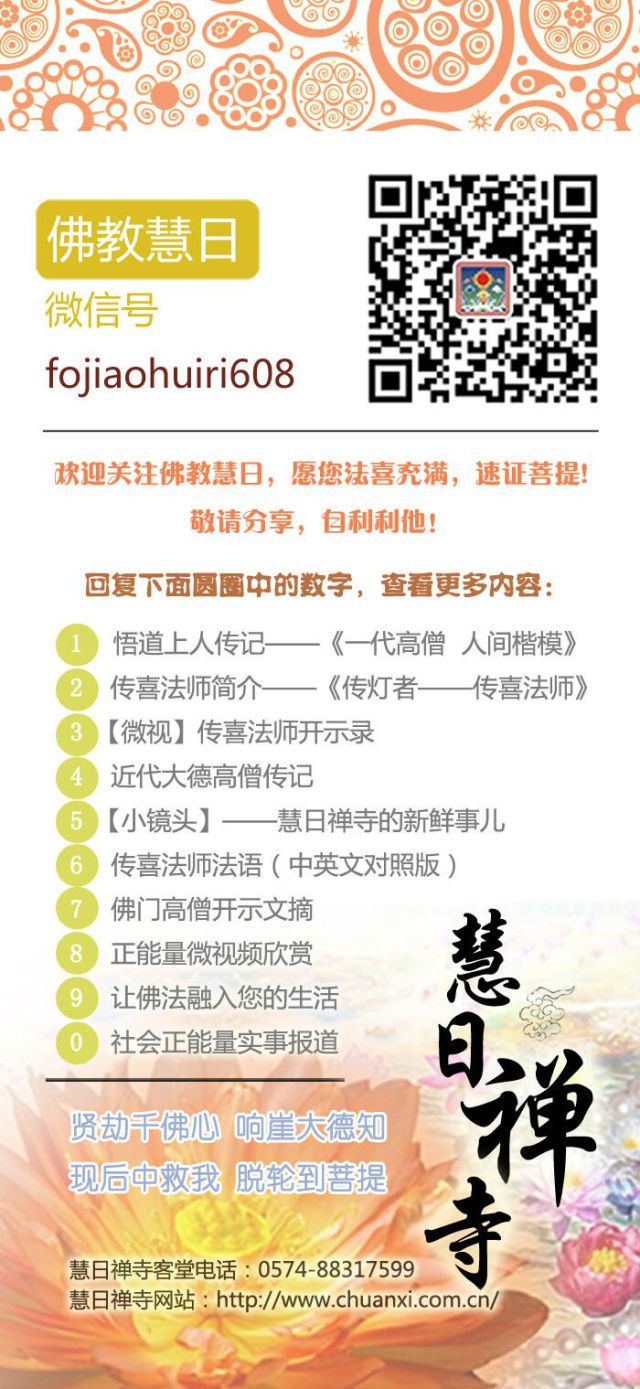英文时分:《永恒的甘露》--《妙法莲华经—普门品》讲记(十四) 传喜法师宣讲

佛对世间根劣的众生说 《阿含经》。 《阿含经》 着重在说 “无我”, 哪里是 “我” 呢? 找找看 “我” 在哪里?胳膊是 “我” 呢? 还是腿是 “我”?还是肝、 肾、 胃是“我”? 对这些肢体部分你会说: 我的手, 我的胃, 显然是 “我的”, 不是“我”。 你找遍里里外外都找不到一个真实的我: 肾坏了可以换一个别人的肾; 胃坏了可以切割, 有的人胃切割了三分之二也能活; 肝也能割掉; 心脏坏了, 安一个人造心脏也可以活。 “我” 到底在哪里呢? 有人说大脑是我, 说大脑思维是靠脑细胞, 但是这个世界上竟有人是没有脑子的, 照样可以思维, 他颅壳里面是一摊水, 什么脑细胞也没有照样活着; 甚至有连整个头都没有的, 也照样活着,这样的例子也有好几个。 所以佛陀就启发我们: 于是身中, 云何为“我”?于是比丘众就在树下岩边, 或者到尸陀林去思维: 什么是 “我”? 由这样不断思维而证得人无我, 证得阿罗汉果位。 所以佛 “思惟是事已, 即趣波罗奈, 诸法寂灭相, 不可以言宣, 以方便力故, 为五比丘说, 是名转法轮, 便有涅槃音, 以及阿罗汉, 法僧差别名”。 佛当初就是以这样子的方便应机说法的, 当时佛陀讲经, 弟子们一批一批地证阿罗汉果。
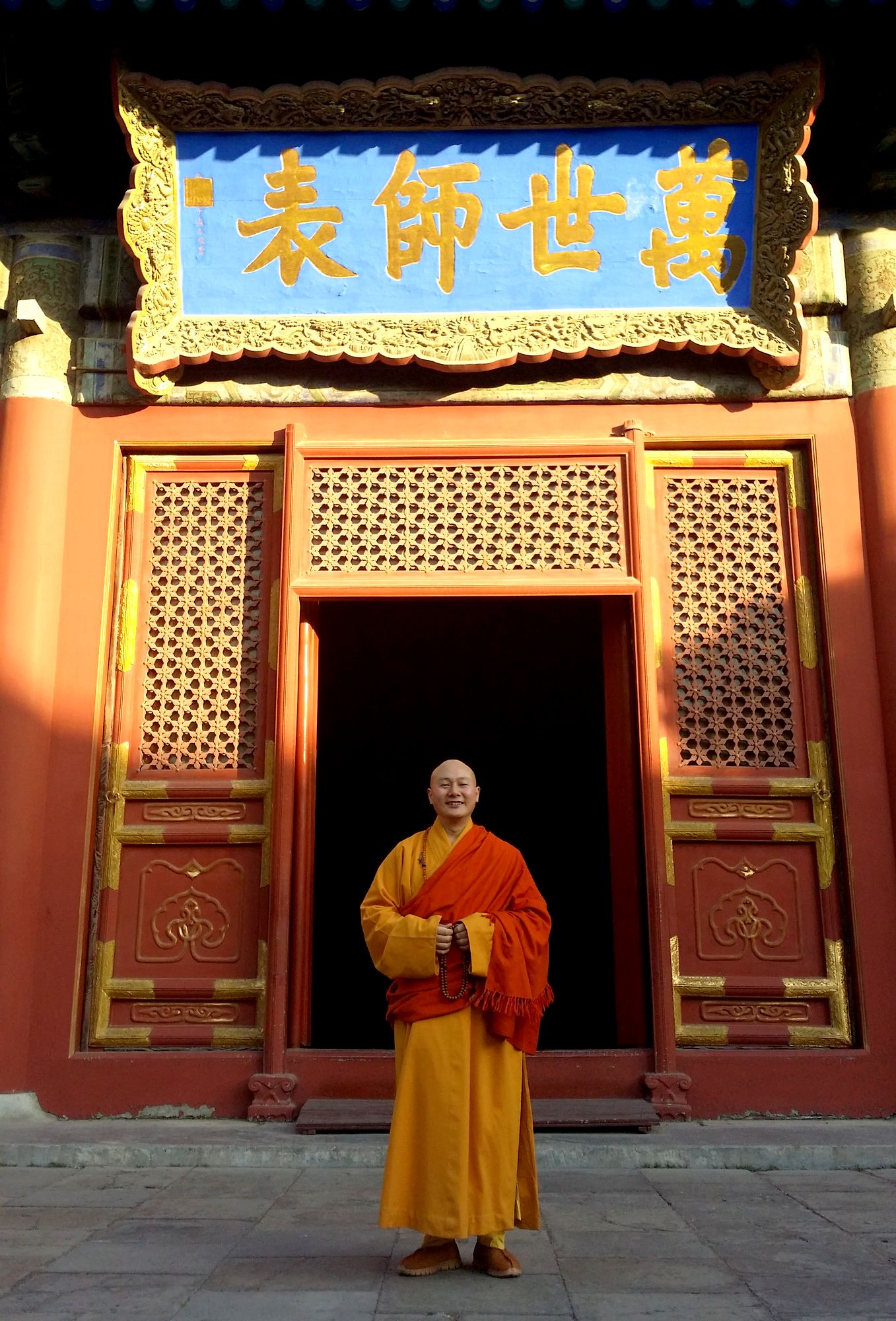
现在末法时代, 人们到庙里烧香, 也不知道佛菩萨是什么, 罗汉是什么,都不知道, 圣者是怎么修来的更不知道, 只知道造庙, 也不知道里面的真实义, 信佛就进入了影像阶段。 最后大家说, 佛菩萨是泥塑的, 这些庙是那些迷信的老头、 老太太造的, 整个就是一个迷信, 应该把这个迷信给铲除掉。 于是, 大家就把佛像给砸了, 把庙给拆了。
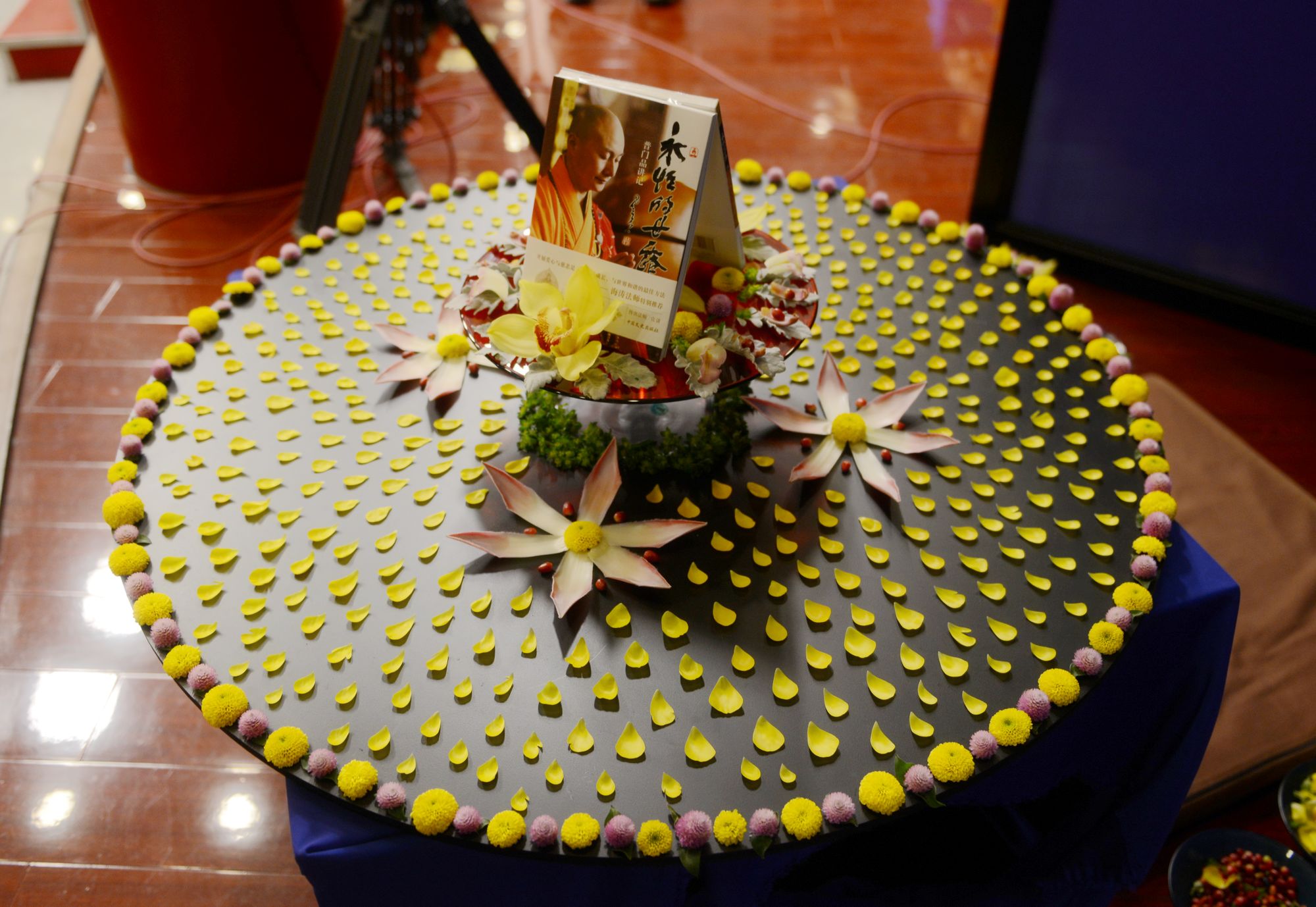
我们现在是像法的末法, 末法的像法。末法时代虽然还有庙, 还有佛菩萨的形象, 虽然有出家人, 但是出家人已经不证圣道; 虽然也有经典, 但很少有出家人能来开显佛经的真实义。 僧分四种: 贤圣僧、 近道僧、 糊口的僧、 无惭无愧的僧。 特别是最后这种僧, 虽然现出家形象, 但却不依佛陀的教导来修行,不持戒律,甚至无恶不作。 现在这个时代, 这种现象也比较多, 所以印光大师就称自己是“常惭愧僧”, 教我们要知道惭愧。 我们现代证得圣道的很少很少, 现在为了能供养到一个圣者阿罗汉得供千僧斋。因为佛陀规定: 若有人供千僧斋, 必须有一位真的阿罗汉去应供。五台山四月十五之后供千僧斋的人很多, 每年要供几十场千僧斋。 供一个千僧斋至少要有十万元左右, 就是为了和一个圣者阿罗汉结个缘。因为如果和一个阿罗汉结了缘, 那是不得了, 舍一得无量报。 但是从修行的果位上来讲, 根器小的才称阿罗汉。 佛说法, 一批根器小的, 或证法眼净— — —初果须陀洹, 或证二果斯陀含, 或证三果阿那含, 或证四果阿罗汉; 根器大一点的, 听佛陀说法发菩提心, 或证初地欢喜地,或证二地无垢地,或证三地发光地, 或证四地焰慧地, 或证五地难胜地,或证六地现前地, 或证七地远行地, 或证八地不退转地, 或证九地善慧地,或证十地法云地, 甚至证无上阿耨多罗三藐三菩提。
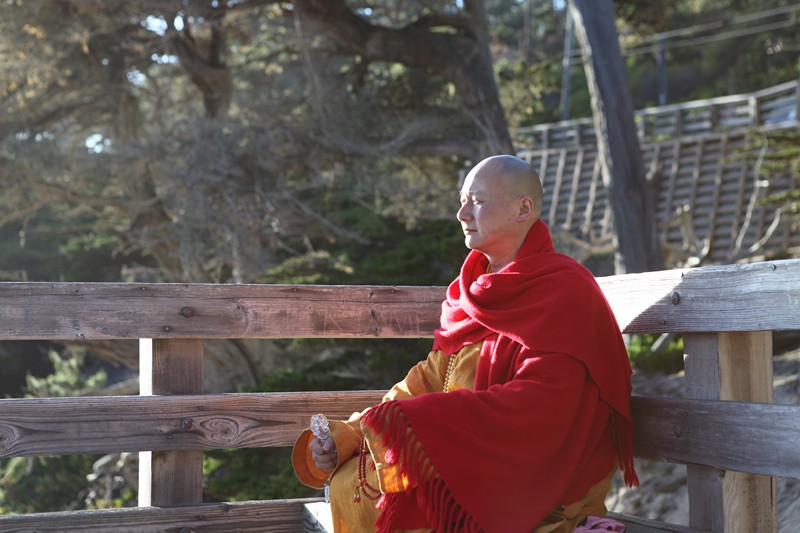
Eternal (Lecture on the Guan Yin Bodhisattva Universal Door)(14)
By Master Chuanxi
The Buddha preached Agamasutra to living beings with an inferior capacity for understanding. The emphasis of Agamasutra is selflessness. Where is the self in us? Is it in the arm, the leg, the liver, the kidney or the stomach? Obviously, this is not the case. As you say that this is your arm, stomach and so on, you cannot find the true self in you nomatter how hard you try to search for it. You can undergo a transplant if your kidney is dysfunctional. You can still continue to live with two thirds of your stomach being removed. The same is true of the liver. You can get an artificial heart if your own is not working properly. In the light of this, where is the self? Some may say it is in the brain as we cannot think without the brain cells. However, there are some people who can still think properly when their brain is damaged with water in it or even their heads are removed from their bodies. Therefore, the Buddha inspired us with the following question: what is the self in us? That is why Buddhist monks sit under trees on rocks; orgo to cemeteries, contemplating the question. Through constant contemplation, they attained the fruit of selflessness and Arhathood. After realising that He should follow the deeds of Buddhas in the past, the Buddha went to Benares to turn the Dharma Wheel. Because the nature of all dharma (nirvana) is independent of all phenomena and it is impossible to expound in any language, the Buddha preached to the first five monks with the power of expedient means. It is since the turning of Dharma Wheel, that terms such as nirvana, Arhat, Dharma and Sangha appeared. The Buddha preached to beings of different capacities with His power of expedient means. At that time, a large number of His disciples attained the Arhathood after hearing the Buddha’s preaching.

Now is the era of Latter Day of the Law of the three Ages of Buddhism. Most devotees neither know truly what Buddha, Bodhisattva or Arhat is; nor how to become a saint through practice. Although they are very keen on building temples, they do not understand the reason behind this. In this age of the degeneration of Buddhism,the true faith in Buddhism has started to wither. Then people will say that all Buddhas and Bodhisattvas are mud statues only, and the temples are built by old superstitious people. Since others believe that all superstitions must be removed, and therefore, the statues and temples must be demolished. 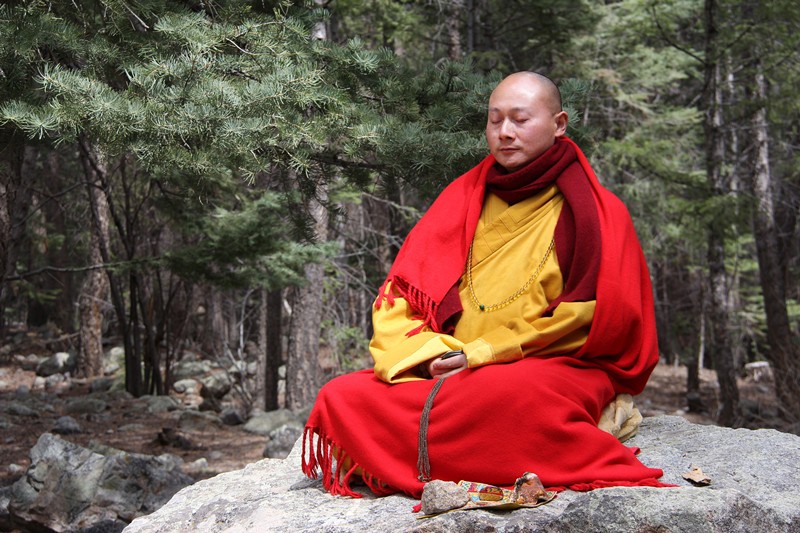
We are living inthe Age between the end of the Middle Day of the Law (the Second Age of Buddhism that is also called the Age of Dharma Semblance) and the beginning of the Latter Day of the Law. In this Age, although statues of Buddhas and Bodhisattvas still exist, and there are monks as well, but they are nolonger able to attain sainthood. Although sutras still exist, hardly any monks are able to expound the true meaning of the Dharma. There are four kinds of Sangha: the sages and saints, the approximate ones, the titular ones, and the shameless ones. The last kind of Sangha does not follow the Buddha’s teachings to practice, nor do they adhere to commandments. Moreover, they even commit evil acts. This kind of phenomenon is prevalent in this Age. Therefore, Venerable Master Yin Guang styled himself as the Monk who is always ashamed, which reminds us that we must reflect upon our behaviour and keep in mind of shamefulness. Nowadays, few people are able to attain sainthood. In order to get a chance to make an offering to one Arhat, devotees need to offer one thousand monks with a meal. The meal is called one-thousand-monk-meal offering. The Buddha made a rule that a genuine Arhat must attend these gatherings to give people a chance to make a connection with him. For this reason, numerous gatherings are held after the 15th of April by the lunar calendar in Mount Wutai every year. In order to form a connection with an Arhat, it costs at least a hundred thousand Yuan to make such an offering to a thousand monks. Yet it is beneficial tocreate such a connection, as it will bring tremendous merits and rewards. However, Arhathood is not the highest holy fruit and is attained by those with small capacity. According to the Buddha, there are four kinds of Arhatship that they can attain: the primary Srota-apanna who can see the truth clearly, the secondary Sakridagamin, the tertiary Anagamin or the Arhat. For people with greater capacities, they can generate Bodhicitta after listening to the Buddha’s preaching. Hence, they can attain ten grounds of the Bodhisattva:
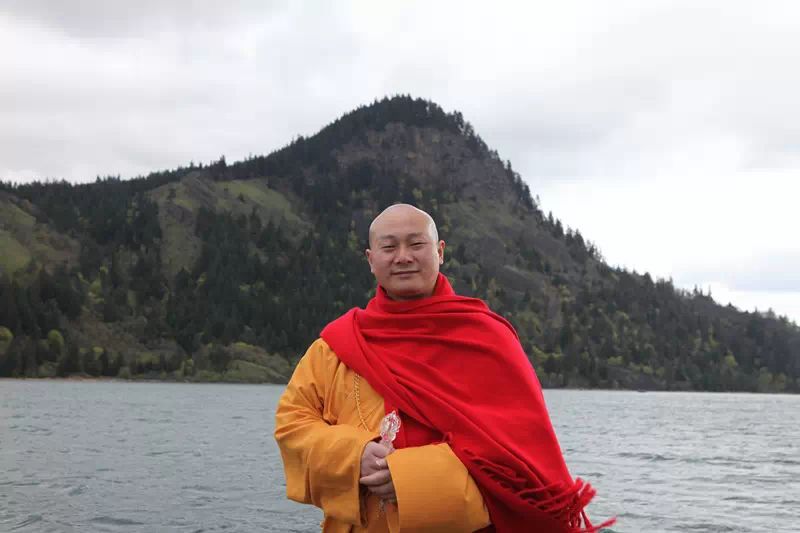
-1Pramudita-bhumi: the Great Joy;
-2 Vimala-bhumi:the Undefiled;
-3Prabhakari-bhumi: the Luminous;
-4 Archishmati-bhumi: the Radiant;
-5 Sudurjaya: the Very Difficult to Overcome;
-6 Abhimuki-bhumi: the Wisdom above Definitions of Impurity and Purity;
-7 Duramgama-bhumi: the Far-reaching;
-8 Acala-bhumi: the Immovable;
-9 Sadhumati-bhumi: the Finest Discriminatory Wisdom;
-10Dharmamegha –bhumi: the Cloudof Dharma.
Moreover, they can even attain the Anubodhi which means the Unbested Complete Enlightenment.

